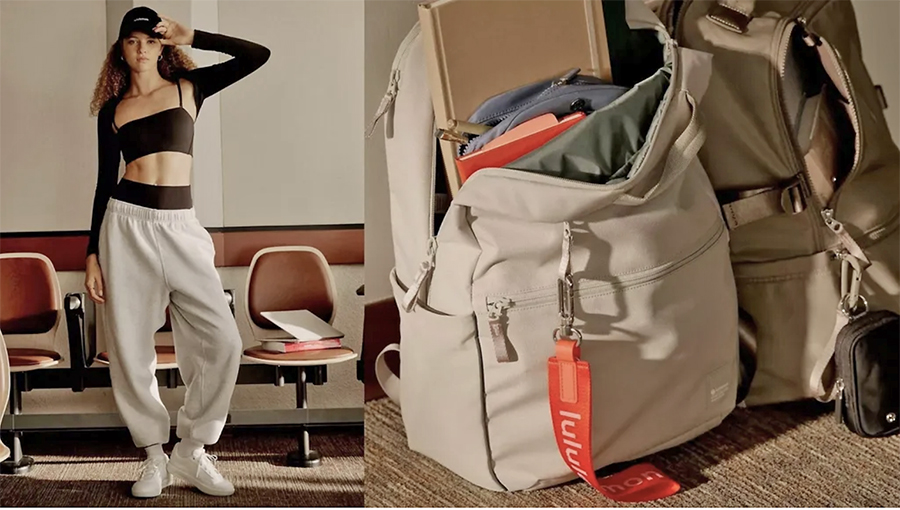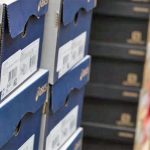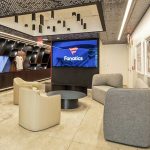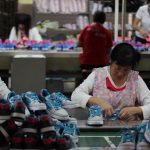The National Retail Federation (NRF) held a webinar on Wednesday, July 23 featuring Katherine Cullen, the organization’s VP of industry and consumer insights, and Mark Mathews, its chief economist and executive director of research, who identified that this year’s back-to-school (BTS) consumers are shopping earlier and with discounters to save money due to ongoing tariff and inflationary discussions. They also expect them to to spend more this year on key BTS categories perceived as “essential,” including apparel and footwear.
“It appears that consumers are still turning up,” said Mathews, when asked how BTS sales are going so far.
“These are solid numbers. Given the circumstances, it looks like consumers are going to spend,” Mathews added. “We know that retailers have stock. This is an incredibly important season for retailers. It’s huge in terms of the amount of spending that happens. I think it’s been a pretty solid season so far.”
Overall, the NRF’s annual back-to-school survey showed families with students in elementary through high school plan to spend an average of $858.07 on clothing, shoes, school supplies, and electronics, down from $874.68 in 2024. Despite budgeting less this year, a slightly higher number of consumers are purchasing apparel and electronics, driving expected total spending to $39.4 billion, up from $38.8 billion last year.
Similarly, families with college-age students plan to spend an average of $1,325.85, down from $1,364.75 in 2024, according to the NRF survey. However, with more U.S. consumers shopping across almost every category, the expected total back-to-college spending is $88.8 billion, up from $86.6 billion last year.
Many Back-to-School Categories Considered “Essential”
Cullen said the shifts around increasing spending within categories were evident among back-to-college shoppers. The NRF’s survey found an uptick in planned back-to-college spending for clothing and accessories, food, dorm and apartment furnishings, as well as gift cards.
“It reminds us that this is still an essential spending category for a lot of students and families. So even though a lot of other occasions might be gift-giving driven, this is one where, every year, college students need new notebooks. They need new pencils. They often need clothes. If you’re moving into a dorm, you need to furnish it. These are things people have to buy.”
The biggest category consumers are pulling back on, according to the survey, is electronics. Cullen noted that electronics are vulnerable to tariffs and BTS shoppers are concerned about related price hikes.
“We saw that while they’re spending on kind of the core electronics – a laptop, a tablet, even a smartphone, they might be pulling back on some of the accessories – maybe headphones or speakers or gaming consoles – and kind of holding off on those because those might be more discretionary purchases. Maybe they can make do with what they own or use a hand-me-down from another sibling or family member.”
Inflationary Uptick Remains Threat to Economy
Addressing the state of the economy, Mathews described the consumer as “sentimentally weak but fundamentally sound.”
He added, “If we look at consumer sentiment data recently, we’ve seen a little bit of a bounce, but in historical terms, consumer sentiment remains very low. However, when you look at the consumer’s finances, household net worth remains near record highs. We have discretionary income growth, and that’s certainly been solid over the last few years. Wages continue to outpace inflation, and that’s super important.”
Mathews further noted that unemployment remains at a historically low level, and while debt remains “incredibly high,” it’s also “manageable from a servicing perspective.” He added, “Lower-income households are a lot more challenged with debt, but overall, economy-wide, we don’t see a huge challenge from a debt servicing perspective. So as long as inflation remains in check, I think recession remains unlikely.”
Inflation remains the major concern, according to Mathews. He said inflation in May came in “lower than anyone expected,” and June saw an uptick but was likewise “a lot lower than people would have expected” given the tariffs. He said the reason tariffs have not yet impacted inflation is that fully phased-in tariffs remain below the effective levels. Mathews said, “We’ve seen price rises in a number of categories, but they’re not really impacting the top-line numbers yet.”
Mathews added, “We know retailers are trying their darndest to keep those back-to-school items in particular as low as possible. It’s also important to recognize that tariff price hikes take historically a long time to work their way to the consumer, and one of the reasons for that is a lot of retailers’ shelves also remain stocked with pre-tariff imports. We know retailers increased imports dramatically at the start of the year so lots of those goods remain on shelves.”
He said inflation will likely weigh on spending more than past recent inflationary periods because the consumers’ saving rate is significantly lower. Recent years have benefited from wage increases that remained above inflation. Said Mathews, “If we see incomes become a little bit more challenging in the face of price rises, it’s going to be problematic for consumers, because they just don’t have those savings to fall back on.”
Mathews is also concerned that businesses may be absorbing some of the tariffs. He said that instead of passing along the higher costs from tariffs through higher prices, businesses may be taking steps to reduce employee counts and wages that “keep our economy motoring along.” He added, “I know that sounds less than ideal if you’re a consumer, but that’s the reality from an economic standpoint.”
Early Back-to-School Purchasing Points to Tariff Concerns
Cullen pointed out the numerous indications that show consumers are concerned about their finances, including shopping earlier for the BTS season than in previous years.
The NRF’s survey showed 26 percent of respondents had started K-12 and college shopping by early June this year, up from 22 percent in 2024 and only 17 percent in 2019. The figure rose to 67 percent, which had started K-12and college shopping by early July, up from 55 percent last year and only 44 percent in 2019.
Cullen said that BTS shopping had started earlier in recent years due to concerns over remote schooling, the supply chain, and inflation, but the jump in early shopping this year shows that consumers are highly concerned about eventually seeing price hikes in the coming months due to tariffs.
“We know tariffs have been a moving target, but there was an expectation that we would start to see some of those go into effect later in the summer and consumers, particularly back-to-college shoppers, began to move up their behavior in a really meaningful way,” said Cullen. “Now that doesn’t mean people won’t shop all season long. We tend to see that behavior, but we are seeing again that focus on early shopping, specifically tied to concern around higher prices and tariffs this year. In fact, almost three-quarters of consumers are expecting to see higher prices this year.”
Back-To-College Shopping with Discounters
Cullen noted that another sign of cautious spending was that back-to-college shoppers in the survey showed an increased intention to shop at discounters, particularly among higher-income households.
Cullen said, “We see consumers trading down brands, buying more store brands, as well as shopping for discounts this year to save money. I will note that K-12 shoppers and their families have consistently been shopping discount as a way to save, so we didn’t really see movement there. It was in that college group where we saw that kind of shift to let me look for different brands, let me shop discount, let me really find some ways to save. Again, college can be a very, very expensive time for many people, especially if you’re sending a freshman off and getting them set up for the first time.”
Among income demographics, Cullen said the NRF survey showed lower-income households have made significant adjustments dealing with price hikes, while higher-income households are beginning to shop more cautiously. Cullen said of higher-income households, “They’re starting to be more worried and, believe, shopping a little more emotionally. They’re also starting to feel like they’re pulling down on their savings a little bit more.”
Middle-income households (earning between $ 50,000 and $ 100,000) have shown some stability due to past adjustments and potential wage increases. Cullen said, “They’ve already traded down. They’re already trading down brands. They’re not feeling the full pinch, but they’ve already made adjustments in the past, and, so, I think that’s why we’re seeing some stability in their behavior right now.”
Gen Z Remain on Top of Trends
Cullen also highlighted some BTS purchase patterns by Gen Z, of which some are in high school and college.
She said Gen Z is similarly showing a shift toward early shopping, but it’s believed to be slightly less pronounced due to tariffs and economic concerns, and partly because of the desire not to miss out on a trend. Cullen said, “They’re worried about things selling out and key items being bought up, and then they won’t be trending, so they’re trying to shop early to get ahead of that. It’s more of a supply chain issue.”
GenZ’s early buying is also traced to confidence in “classics,” or “things that you know you can’t go wrong with if you buy now,” believes Cullen. She noted that sneakers and footwear have been a ”growth category and a focus for both back-to-school and back-to-college for some time now,” but backpacks are showing an uptick in demand this year with the category being showcased on TikTok conversations. Cullen said, “We are seeing a lot of focus on backpacks this year, a lot of focus on specific backpack brands, on ‘What’s in your backpack?’, on what type of backpack you’re buying and asking for recommendations and conversations around that on social.”
Tariffs Impact on Holiday Spending
Asked in the Q&A session about the potential impact of tariffs on holiday selling, Mathews said it’s hard to determine with the uncertainty around tariffs. He elaborated, “The challenge has always been that it’s very hard for retailers to plan when they don’t know where the tariffs are going to be. So, I would say it’s really challenging to understand the impact without knowing that if those tariffs come in on August 1, are they going to be gone in August 15 or are they going to last for a longer period of time. I think if they last for a longer period of time, it’s very hard not to see some impact as we head into the holiday season, and potentially earlier than that.”
Cullen added that last year’s holiday season could foreshadow how this upcoming one may play out. Last year, holiday shoppers’ concerns over inflation led many to narrow their view of what’s “essential,” similar to expected BTS patterns.
“[Holiday] is an essential spending category for many families,” she said. “They want it to feel special for their kids. They want to celebrate it and they are protective of that spending in a lot of senses, or at least that’s what we’ve seen during times of stress. And, so, what we are seeing, though, is that people tend to pull back a little bit on how they define who their family is – maybe focusing more on their core family or immediate family and really focusing on spending there, rather than kind of buying for extended family, such as for acquaintances. I also believe we’ll continue to see early shopping, particularly if there are some concerns around imports and availability of products.”
Image courtesy Lululemon
















